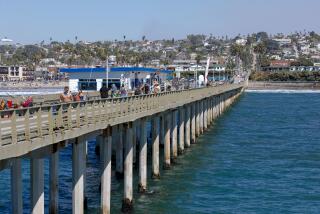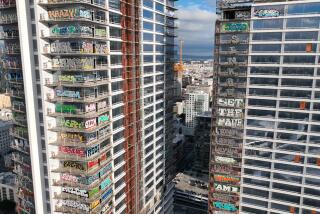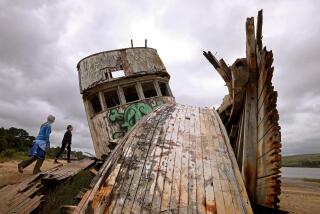Hospital Ship Conversion Project Hits Financial Shoals
Like a ghost ship at the mercy of the elements, the Oceanic sits idly in the harbor.
Below the bare decks, darkened passageways strewn with debris lead to crewâs quarters containing bunks without mattresses and toilets without plumbing. On a table near the bridge lay two old maps, one of the Maine coast, the other showing New Yorkâs Hudson and East rivers from Governorâs Island to 67th Street. In the galley next to a bowl of rotten grapes and a crumbled cigarette carton, a dusty guest book bears entries that end on Jan. 31.
That is the last time anybody but journalists has been aboard the Oceanic. For more than a month, the vessel has been anchored a few hundred yards offshore near the Long Beach Naval Station in the Port of Los Angeles.
There are those who envision the ship--which is painted white with a huge red cross on its side--as a majestic floating hospital that will one day carry volunteer doctors to needy ports in Mexico and Central America. In reality the vessel, accessible by water taxi at a fee of $100 an hour, is at the center of a bureaucratic dispute that may keep it anchored for some time.
The most immediate problem is that Los Angeles port officials will not let the ship berth until it can operate under its own power. But its skipper says the ship canât operate under its own power until port officials let it berth for repairs.
The project âjust might go down the tubes,â complained Tom Keegan, a former Merchant Marine captain, now in a wheelchair, who skippers the Oceanic. âThat would be sad for everybody.â
Counters Ed Hill, the portâs chief wharfinger: âThe shipâs a long way from being operable. Putting her in port would be dangerous.â
Keegan, 49, first conceived his dream of delivering medical supplies and services to Third World countries after a 1985 motorcycle accident paralyzed him from the chest down, ending a seagoing career that had spanned 25 years. Becoming acquainted with the medical technology that saved his life, he said, helped him recognize the dearth of proper medical equipment and services in many of the ports he had visited.
âPeople south of the border in my condition wouldnât have survived,â he said. âThey donât need food down there as much as they need medical attention.â
When he heard of an available ship with 7,500 square feet of covered deck space and 800 tons of storage capacity, the captain rejoiced. Built by the Canadian government in 1969, the Oceanic--formerly called the Atlantic Jag--served as a tuna clipper for several years before being purchased by Sea Trec Enterprises Inc., a shipbuilding firm in Chula Vista that intended to convert it into a salmon processor. But financing for the project fell through, leaving the 200-foot vessel tied up and losing money. When Keegan suggested converting it into a hospital, the owners agreed.
âHeâs a pretty convincing chap,â said Sea Trec owner Doug Lotoski, whose wife is a nurse. âHeâs got a good idea, the ship would be ideal for the project and he is very very sincere. So we thought weâd give him a shot.â
Although Sea Trec still owns the vessel, Lotoski said, the company has agreed to sell it eventually to Keegan for an unspecified amount. In the meantime, he said, the captain has full possession of the vessel as he attempts to add four operating rooms, eight recovery beds, three dental chairs, an X-ray machine, orthopedic unit and complete blood lab.
Just how he intends to accomplish all that is still rather vague.
Nonprofit Status
To begin with, Keegan set up a nonprofit organization headed by Dr. Alton Ochsner, a New Orleans surgeon. âThe idea is very good,â said Ochsner, who also heads a private foundation that provides medical aid to the indigent in the Caribbean. âWeâve been slow in getting this thing going.â Ochsner said he first heard of Keeganâs work through a mutual friend in the medical community.
Others listed as members of Keeganâs board of directors include Dr. P. William Oysinger, a professor of internal medicine at Loma Linda University; Frank C. Flores Jr., a dentist on the staff of the USC School of Dentistry; Robert E. Green, a dentist in private practice in Highland, Calif., and Alejandro Rostran, a member of the New Orleans Chamber of Commerce.
According to Keegan, the proposed remodeling of the Oceanic--as well as the plans for its eventual operation with the help of volunteer doctors and crew members--is being overseen by board members and various volunteer medical technicians. The remodeling work, he said, will be done by several local maritime unions that have offered to work for free.
A spokeswoman for San Bernardino Community Hospital, where Keegan once was a patient, said hospital staff members are collecting used medical equipment to donate to the project.
Support Promised
The captain also carries a sheath of letters from foundations, private companies, medical centers, doctors, hospitals and politicians promising various levels of moral, material and financial support.
What Keegan does not have much of, however, is cash.
So several weeks ago he moved the ship up the coast from San Diego to San Pedro in an effort to attract more attention and thereby generate more contributions. Because of a defective generator and other problems, however, the ship had to be towed all the way. Now, its inability to move under its own power has become an albatross that threatens to sink the project altogether.
Although the U.S. Army has offered to let Keegan use one of its docks for the 90 days he estimates it will take to convert the Oceanic to medical use, the dock at Berth 55 in San Pedro was not immediately available the day the vessel arrived. So port officials decided to give the ship temporary berthing nearby. But after a short grace period during which little apparent progress was made, they had the ship unceremoniously towed to its present out-of-the-way location in the outer harbor.
He Needs Three Weeks
âThatâs a surge area,â Hill said, referring to the fact that the Armyâs Berth 55 is subject to changing tide levels, which sometimes require vessels to be moved. âWe donât put dead vessels there,â he said.
Keegan says he needs at least three more weeks in port to do the repairs necessary to make the ship seaworthy. Hill says that to let an inoperable ship tie up any longer would have constituted an unacceptable hazard. And hanging over everything is the $114-a-day tariff normally charged by the port for ships the size of the Oceanic.
Keegan says he canât afford the tariff and that it ought to be waived. Hill says that a decision to waive the tariff could be considered only if Keegan can prove that the Oceanic is a bona fide relief vessel destined for a country considered stricken.
âNo vessel is a relief vessel if itâs dead in the water,â the wharfinger said. â(Keeganâs) been treated very generously by the port, but we have our limitations.â
More to Read
Sign up for Essential California
The most important California stories and recommendations in your inbox every morning.
You may occasionally receive promotional content from the Los Angeles Times.










